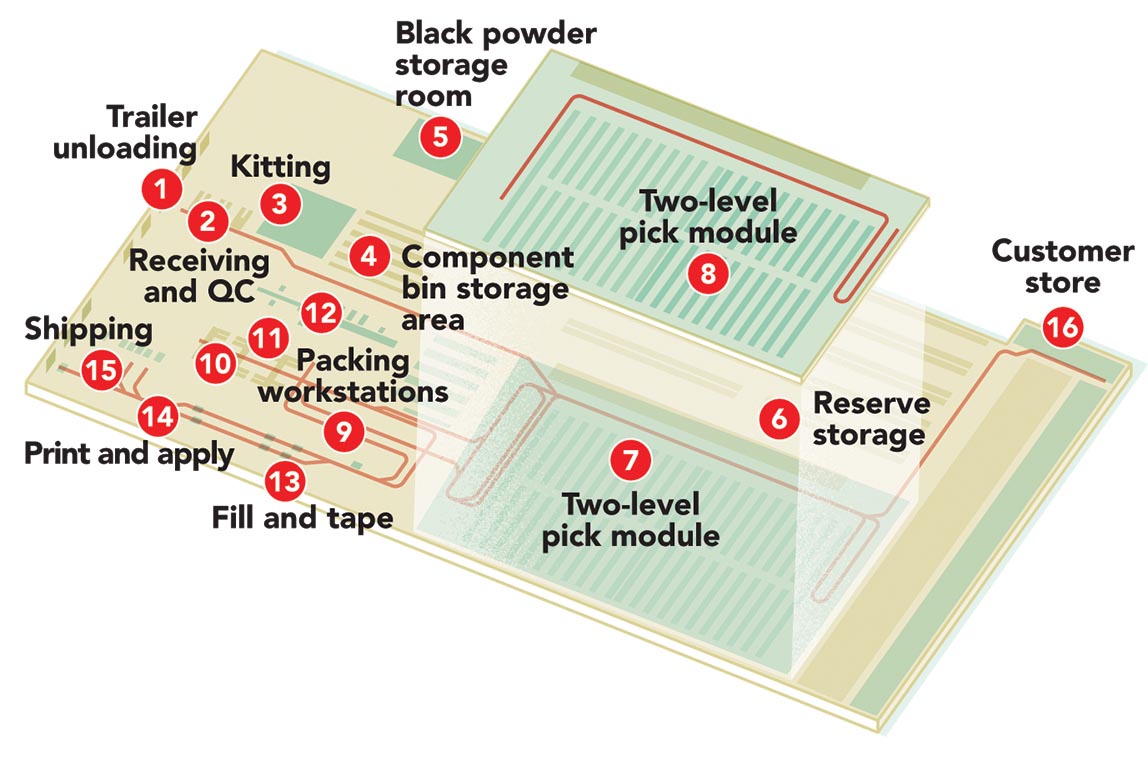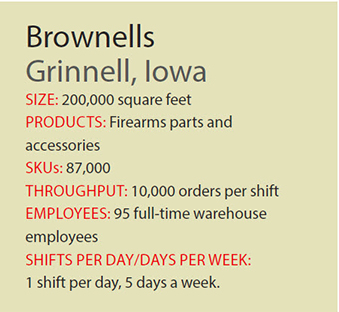System Report: Brownells new DC is flexible and responsive
With conveyor, a WMS and put-to-light technology, Brownells has improved productivity and efficiency while being more responsive to its customers.
A leading provider of gunsmithing tools, parts and accessories, Brownells has established an industry-leading position with its new distribution center.
Receiving:
Trucks are unloaded in the trailer unloading area (1). From there, they are scanned into the warehouse management system (WMS) at pallet-flow fed workstations in the receiving and quality control check in area (2). Items that are new to the system are weighed and cubed. Once items have been received, they are scanned into a tote for storage. Totes are conveyed to one of the pick module zones (7 or 8), or moved by carts or pallets to the component bin storage area (4), the powder storage room (5) or to selective racking in reserve storage (6).
Putaway:
Items are putaway into storage mediums using WMS slotting rules. The fastest moving items will be stored in the multi-level pick modules (7 & 8). Totes accumulate on carts that hold up to 12 totes. Once a cart is full, the WMS directs an operator to a storage location. Materials for kitting are stored in the component bin storage area on shelving (4), while heavy, odd shaped and slow moving items, as well as active reserve inventory, are stored in the reserve storage area (6). Finally, ammunition is stored in the powder storage room (5).
Kitting:
Some items are kitted together in the kitting area (3). To start the process, components are transferred from the component bin storage area (4) to the kitting area (3). There, the WMS identifies the items for a specific kit, and then create a new SKU for the kit. At that point, the kits are placed on the receiving conveyor for put-away in the pick modules (7 & 8).
Overview of the distribution center

Picking:
The WMS batches orders based on criteria, such as whether it’s a rush order; one-line, one-piece orders; multi line, multi piece orders; and the pick zone where items are located, to name just a few. Batched orders are assigned by the system to a fixed tote ID, which is then routed to one of the seven picking zones in the pick modules (7 & 8). Operators scan the tote ID and are directed in an optimal pick path using an RF device until all of the picks in their zone are complete. The tote is placed back on the conveyor for routing to the next pick zone or to one of the packing areas packing (9, 10, 11 & 12) when all picks have been completed. 
Store pick up:
When a customer places an order in the store (16), the host system passes a special order request to the WMS, which expedites the picking request. Picked items are placed in a tote and conveyed from the pick module (7 & 8) directly to the walk-in store in minutes.
Order consolidation and packing:
Completed totes are routed directly to one of 10 put-to-light order consolidation and pack stations located across four areas.
The “fast-pack” station (9) handles one-line, one-piece orders. An operator scans the tote to identify the orders to be processed. As the operator then scans and places each piece into a shipping envelope or box, the WMS ”checks off” the corresponding open order as complete. The envelope or box is then routed on the outbound conveyor to fill and tape operations (13), and through an automated print-and-apply ship label system (14).
At the small (10) and medium (11) put-to-light and pack areas, an operator scans the Tote ID, which triggers the WMS to drive the consolidation logic for an order. The operator is directed by lights into which “lean bin” to consolidate the order. After all the items required for the order have been accurately placed into a “lean bin,” a completed order light indicates to an operator on the opposite side that the order is ready for packing. The orders are placed in the shipping box and conveyed through the fill and tape (13) and labeling operations (14).
Orders requiring odd sized items or special packing needs are conveyed to the “freight” pack area (14) for manual order packing.
Shipping:
After all orders are properly picked, packed, weighed and labeled, they are sorted based on best parcel shipping method (15) for truck loading.













